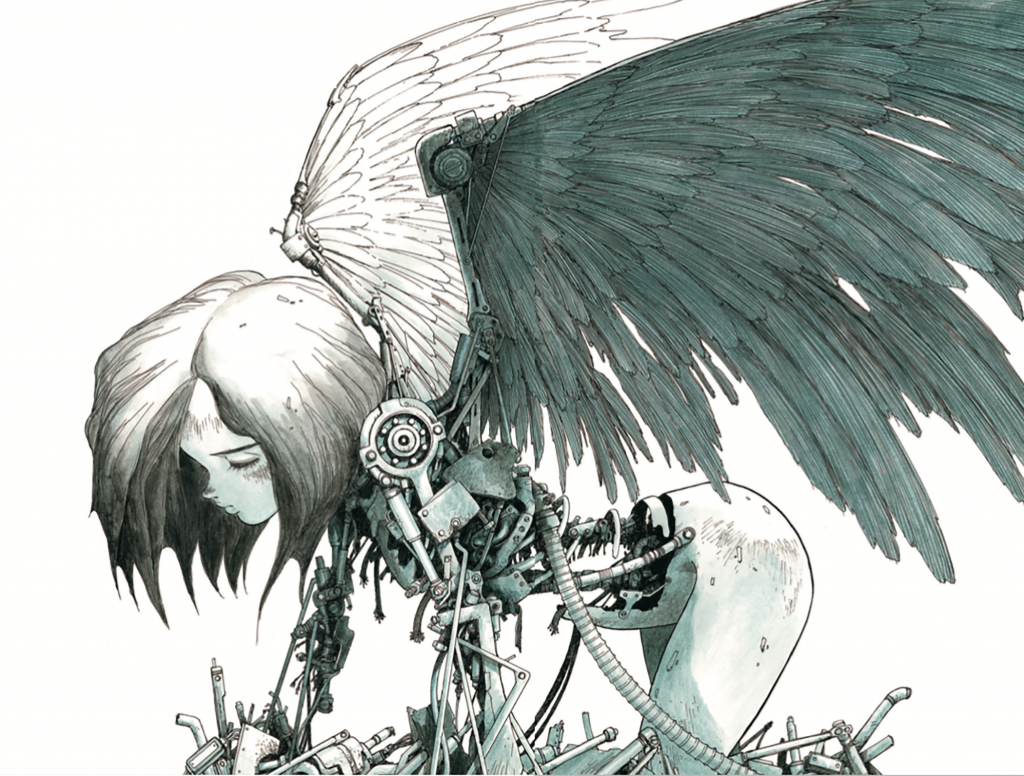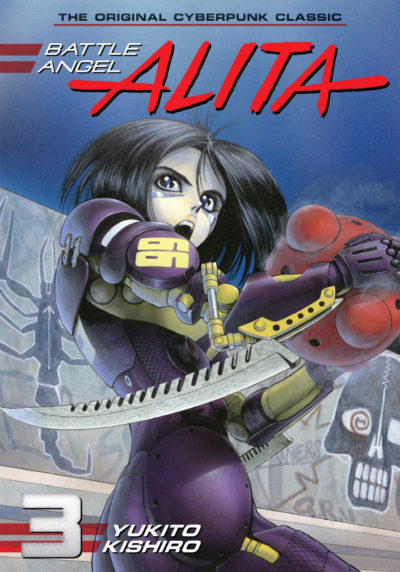
Literary rating: ★★★★
Kick-butt quotient: ☆☆☆☆½
 I used to read a lot of comics and graphic novels. But when I moved from London to Arizona in 2000, I all but stopped. There are still boxes in our basement, unopened since then, filled with my comic collection. Rare have been the forays into that culture since, beyond the occasional volume of Dirty Pair, for review purposes. Certainly, nothing as extended as deciding to re-read this in advance of the anticipated release of Robert Rodriguez’s live-action movie. Initially, I feared I had bitten off more than I could chew, when I realized the nine-volume series was a total of over two thousand pages of content. Maybe I should have started reading it before mid-October?
I used to read a lot of comics and graphic novels. But when I moved from London to Arizona in 2000, I all but stopped. There are still boxes in our basement, unopened since then, filled with my comic collection. Rare have been the forays into that culture since, beyond the occasional volume of Dirty Pair, for review purposes. Certainly, nothing as extended as deciding to re-read this in advance of the anticipated release of Robert Rodriguez’s live-action movie. Initially, I feared I had bitten off more than I could chew, when I realized the nine-volume series was a total of over two thousand pages of content. Maybe I should have started reading it before mid-October?
In the end, the release date for the movie got pushed into next year, and I blitzed through the comics at about a volume per day, in virtually my usual reading time. I’d forgotten how pacy comic reading can be: if there’s no dialogue, you scan the panels quickly. It’s not as if you stop and admire them, or worry about what exactly is being portrayed. The intent is almost for the visual aspect to go from the page into your subconscious, so you get a visceral “feel” for what’s happening. That’s especially true for something as heavily action-oriented as this, and Kishiro has an amazing flair for it (not least in the area of sound effects!). If you look at an individual frame, you might not know what’s happening; yet put them together, and almost magically, it becomes a coherent flow.
Ho wever, there’s still an amazing amount going on in terms of story-line and universe-building. You can easily see how the feature film will only be able to cover perhaps one-quarter of the series. I presume it will begin with the origin story, in which Ido finds the head of Alita in the scrapyard beneath the floating city of Tiphares, and gives it a cybernetic body. He’s a part-time bounty hunter, only to find out quickly, the combat abilities of his new charge far surpass his own. Unfortunately, she has little or no memory of her prior life; where she got these skills and how she ended up in the scrapyard is only revealed well into the series.
wever, there’s still an amazing amount going on in terms of story-line and universe-building. You can easily see how the feature film will only be able to cover perhaps one-quarter of the series. I presume it will begin with the origin story, in which Ido finds the head of Alita in the scrapyard beneath the floating city of Tiphares, and gives it a cybernetic body. He’s a part-time bounty hunter, only to find out quickly, the combat abilities of his new charge far surpass his own. Unfortunately, she has little or no memory of her prior life; where she got these skills and how she ended up in the scrapyard is only revealed well into the series.
The second volume has her both falling in love, and discovering the pain which love can bring. She is smitten by Hugo, another young orphan of the scrapyard, who is working hard – albeit in some very dubious ways – to raise enough funds to buy a ticket up to Tiphares. When he discovers the truth about his situation, he cracks – and a bounty is placed on his head. The end result is romantic tragedy of a high order, and also drives Alita away from Ido. That brings her into the middle arc: motorball, a superviolent pastime popular among the scrapyard inhabitants. This occupies the third and fourth volumes: Alita climbs the sport’s ladder towards the elite players, and ends up facing off against its brutal champion, Jashugan. It appears this is roughly the arcs which will be covered in the film version, though I’m not sure how far they’ll get into the motorball thread.
The second half sees Alita head into the wastelands, in search of Desty Nova, like Ido another Tipharen exile. She has become an agent working on behalf of the floating city, and against the rebel group of Barjack, which is intent on (literally) taking down Tiphares. While this gives her access to help from above, the flow of data goes both ways: if one Alita is good, wouldn’t a dozen of them be better? Through Nova, she discovers the gruesome truth about the citizens of Tiphares, and her convenient amnesia is also cured, with Alita remembering where she came from, as well as finding out the history which led to the current situation on Earth. She’s left to make the ultimate choice: whether to destroy Tiphares or save it.
It having been more than two decades since I last read this, I’d forgotten almost all the details, so the twists and turns proved highly effective once more. There were several moments where I had to put the book down and just absorb what I’d been told, and Kishiro is good at telling the reader the essential information efficiently. However, it’s the action sequences throughout where he really shines, whether it’s the motorball contests, or the escalating series of battles in which Alita finds herself involved. For no matter how powerful she may become, there’s always someone bigger and badder – likely culminating in Den, leader of the Barjack rebels. Imagine a pissed-off half-horse, half-Transformer. Yeah, he’s like that.
While they certainly would not be cheap, there’s enough material here for a whole franchise of live-action movies, if the first one is a success (fingers crossed, though I’m not optimistic it’ll take in the half-billion or more needed for it to turn a profit). I’m really looking forward to seeing what Robert Rodriguez can do with the adaptation, on the largest cinema screen I can find. Hopefully his vision of Tiphares, the scrapyard and Alita is able to live up to the impressive world created by Kishiro.
Author: Yukito Kishiro
Publisher: VIZ Media LLC, available through Amazon, both as a paperback and an e-book













